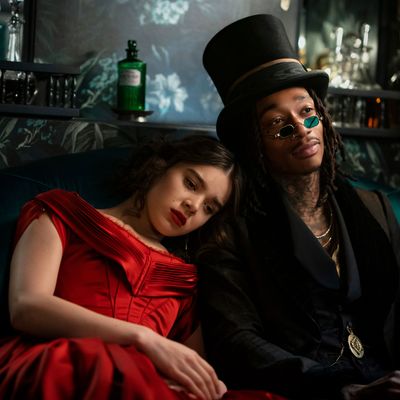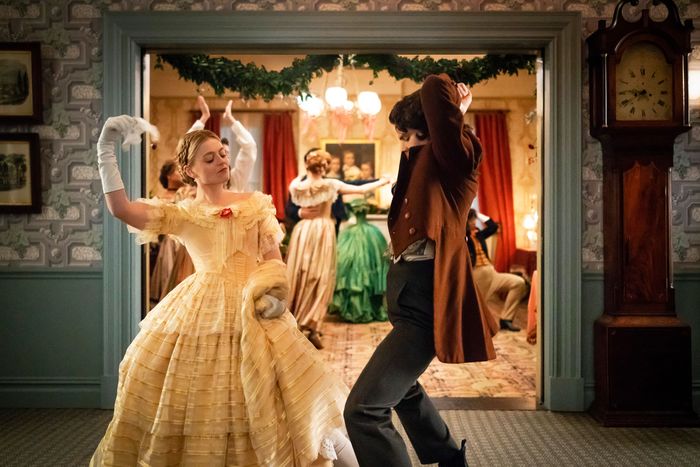
I expected a prestige television show about Emily Dickinson to be gauzy and somber, with white dress hems vanishing around doorways, at least one townsperson peeking over a fan to whisper conspiratorially about “The Myth,” and a copper bun so severe the poet’s temple veins would pulse in HD. There would be a lot of gazing — so much gazing, so very much gazing — and rippling wildflowers and at least one overhead shot of the poet lying in a field of untended native grasses, wondering (we would assume) if the world will ever recognize her quiet genius.
Honestly, I probably would have liked that show. Or watched it, at least, with that sensation of gratitude that flutters in my abdomen anytime a brilliant woman is given a small bit of her due.
Instead, this week we get Dickinson, a new series from Apple+ that grabs the word “biopic” and blows a mouthful of pot smoke in its face. What a sharp, delicious hit it turns out to be. This Emily (played with impeccable teenage whininess and punk-rock defiance by Hailee Steinfeld) isn’t the ghostly poetess of high-school textbooks. She doesn’t tiptoe up the stairs when guests ring the bell at the Homestead. She’s an opium-dosing, cross-dressing, open-mouthed kisser. And the show that surrounds her pulses, as though everyone involved in its production dropped acid together right before every call time. It’s a wild desecration in so many ways, a betrayal of the grand tradition of literary screen bios, and I love it.
Let us count the ways in which we’ve been force-fed dour, vitamin-deficient biopics of our favorite authors. In this summer’s Vita and Virginia, Woolf and her sometime lover gaze at one another across rooms, whisper their fingertips across one another’s bodies, and stomp about in period garb declaring just how wildly unconventional they are. It’s fine, I guess, but where’s the convulsing orgasmic joy and pain? For a portrait of a woman who heard birds singing in Greek, there’s a lot of posed, elegant pontificating. Sylvia, the 2003 film about Plath’s marriage, its upheaval, and her suicide, excelled only in showing off Gwyneth Paltrow’s sculpted blond bob and elegant profile. The Edge of Love, a not-fictionalized-enough account of Dylan Thomas’s marriage, was crammed full of beautiful British talent — Keira Knightley, Sienna Miller, Cillian Murphy, Matthew Rhys — and then quickly drowned in the booze and brawls that script writers always assume audiences want to see.
Why. So. Serious. On top of being ponderous, such work bristles with the insecurity of filmmakers timidly making the case for long-dead writers; every hushed scene screams the anxious question: Will people take their work seriously if we don’t present them seriously? Not that every somber move is a false one. Sometimes gravity works (see: Bright Star, the dream state of a film about poet John Keats, or Capote, the Philip Seymour Hoffman masterpiece). But more often it fades into the period wallpaper.
Sometimes, of course, experiments go awry (see: Midnight in Paris in totality). We have a more substantial body of work in the realm of updated period fiction, rather than writers’ biographies: the polarizing reboots of Baz Luhrmann (Gatsby, Romeo+Juliet); Ethan Hawke as a po-mo Hamlet; Robert Downey Jr.’s rakish Sherlock. In all these cases, your mileage may vary. (Personally, I can handle dreamy Romeo Leo, and that’s about it.) But messing with actual, once-living literary idols has for some reason bent toward humorlessness and rigidity. Until now.
Dickinson offers a master class in fucking with your literary idols. Creator and writer Alena Smith rigidly adheres to some details about the poet’s life; for instance, the set design of the Homestead, the Dickinson family manse, is exact — they only widened some rooms to make space for the cameras — down to the accurate floral wallpaper in Emily’s bedroom. The peripheral characters all have the names of people who really lived in Amherst when Dickinson was alive. Emily learns how to bake bread; the real Dickinson was famed for hers (well, in Amherst at least).
All that precision builds a stable platform for the funky, wild abandon that Smith stages on top. That bread turns orgasmic when it rises and rises in a roaring oven while a female character comes. Anyone who’s read Dickinson knows she was fascinated by sex, but rather than portray her internally quivering at the thought of a vagina, Smith has her getting fingered in bed. Writers, they’re just like us! This isn’t a parody of Dickinson and her life. The joke is instead on contemporary readers who have twisted her up like a soft-serve ice-cream cone.
Give me more of this. More, more, more.
Why not a Walt Whitman biopic set in the 1980s in which he rolls around in pre-gentrified Prospect Park, studying the blades of grass after swallowing a friend’s old Quaaludes? How about a 1940s-set Patricia Highsmith series devoted entirely to the day she became enamored of a Bloomingdale’s customer and followed the woman home? I’d absolutely devour a show in which Virginia Woolf slips up and down the gender spectrum like Orlando, morphing into Greek goddesses and Ottoman emperors. An animated Philip Larkin show helmed by a bird and drawn by the Instagram artist @falseknees. Edith Wharton just mercilessly gossiping about Edmund Gosse, William Dean Howells, and her own husband while she selects fabric swatches for her parlor at the Mount.
I do understand the visceral discomfort of being thus fucked with. As a reader who’s glommed onto certain writers as totems of my own literary life, the tendency to shove them under a glass cloche feels familiar. When I realized that the show’s Dickinson was setting down some of her most famous poems out of chronological order, my first instinct was to clutch my Complete Poems to my chest. But why not live a little? In a show about a poet a hundred years ahead of her peers, does time even matter?
Dickinson is irreverent as hell, but irreverence alone can’t do all the heavy lifting for this or future biopics. A deeper accuracy has to redeem the sacrifice of literal truth. When Emily and her lover–cum–sister-in-law Sue strut around to Lizzo’s “Boys” while pulling on men’s clothes, it doesn’t work because 2019 is colliding with 1850, and tee-hee, that’s funny and strange. It works because in 1850 Dickinson’s poetry was as empowering and fresh as Lizzo’s lyrics and persona, and the sight of her seductively pulling a cravat across her throat is Dickinsonian as fuck, even if we don’t have proof it happened.
Tethering all the silly is Smith’s ability to give us what we really want — more choice meat on what made Emily Dickinson tick. This Emily stays home because work calls to her, because she craves immortality. There is no self-imposed punishment or romantic exile. Is that the truth? Did Emily really forsake marriage to stay home and care for her father so that, in turn, he might give her wide berth to sit alone with her thoughts while candles burned low? It’s one truth. And it opens Dickinson up to us, rather than encasing her in scholarly carbonite.
Once, on one of my many visits to the homes of my idols, I wandered Dickinson’s Homestead alone, chasing the literal in the literary. It was snowing heavily, nearly New Year’s Eve, and the curator on duty gave me permission, as the house’s only guest, to head down the hall by myself for a minute. I glanced up the steps and imagined Dickinson hiding around the bend, listening to my footsteps and scribbling me a little note on the back of an old receipt, something she might drop out of her window in a basket. Dickinson’s Emily does that once, passing a note to Sue arranging to meet in the orchard, where they end up slipping their tongues into one another’s mouths. Damn, I like this Emily better than the one I thought I knew.


